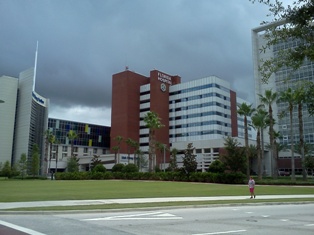|
Urban Developers Bank on SunRail to Change Central Florida Driving Habits  If the 62-mile long rail line attracts enough riders it could reduce congestion on roads like I-4 and attract people to live and work around the rail stations.But developers are worried if SunRail isn't done right both their projects and the commuter line could flop. The SunRail tracks run straight through Florida Hospital’s campus on North Orange Ave, and the commuter train is an important part of the hospital’s plans for a Health Village. Developer Craig Ustler says the project will transform the surrounding neighborhood. “It would look like a lot of people walking, a pedestrian friendly environment, and maybe an evolution to a place where the car doesn’t win all the time," says Ustler. He's counting on residents filling up 250 apartment, 38 million dollar complex he’s building a few blocks from the hospital. The health village will include a mix of homes, shops and businesses clustered around the rail station, all part of a concept called Transit Oriented Development. The idea is to create pedestrian- friendly environments with access to transportation alternatives to the car, whether it’s rail, cycling, or buses. Local officials say it has big potential. At SunRail's groundbreaking last year, Orlando Mayor Buddy Dyer spoke about Transit Oriented Development sparking urban renewal around the new train stations, "giving us new places to work, live and play; new companies moving in, new jobs being created." Residents in Craig Ustler’s apartment complex will be a short walk from the Florida Hospital SunRail stop- which will be built steps from the front door of the hospital. With ten thousand employees and three thousand students at the College of Health Sciences, all of them potential rail passengers, shoppers or tenants, the hospital is ripe for Transit Oriented Development. To make it work, though, the rail has to run often and on time. Right now SunRail won’t run on weekends. Gregg Logan, managing director of the Orlando real estate advisory services firm RCLCO, says that could be a problem. “If it’s not convenient, then people won’t use it and that will be a self fulfilling prophecy of ‘see, we shouldn’t have funded it because people aren’t using it,'" says Logan. SunRail says it will extend the service if there’s demand. Transit Oriented Development is still untested in Central Florida, and that’s made it challenging for developers to get financing for big projects around rail. Compared to cities with well established mass transit like New York, Central Florida’s urban environment is relatively young, with most of the big growth springing up in the last 50 years. But, Gregg Logan says that could be a good thing. “The good news is we can go to some of these other places and look at what worked, and borrow some of their best ideas.” Logan says Central Florida should take inspiration from Portland’s street car and the Washington DC Metro, where Transit Oriented Development has driven up the value of land around rail stations. While Florida hospital has big plans for development, some of the other stops along the rail line aren’t as far advanced. One landowner trying to attract business for a potential development is Tupperware. Spokesperson Thomas Roehlk says the company has 100 acres for mixed use set aside at its headquarters near the Osceola Parkway station. “We haven’t had the interest yet from businesses, partially as a consequence of the fact that we are in phase two, so we’re four years out from having a station, and secondly just because of the slow uptick to the economy,” he says. Roehlk believes Tupperware’s plan will succeed in the long run because of the location’s proximity to another major transport hub- Orlando International Airport. Meanwhile, developer Craig Ustler says once the train starts running past his building at Florida Hospital, Orlando residents will begin to see the potential for a well planned urban environment. “I think the vast majority of people have woken up to the fact that living 30 miles away from where they work, and driving, and the price of gas and all that is probably not the most efficient thing in the world," says Ustler. "We still need some time to work through exactly how to fix that and how to give people the tools to make a move.” Ustler breaks ground on his apartment complex next month. The first stage of SunRail is slated to start in 2014. |
|
|